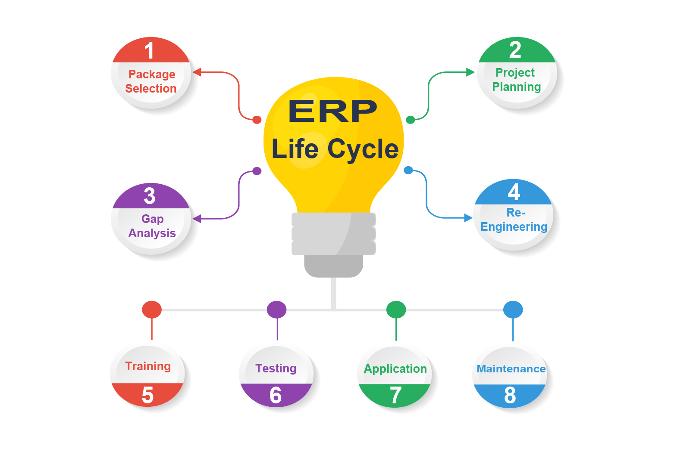ERP implementation is substantial for both human as well as business resources. Once the implementation is carried out successfully, the businesses can start reaping the benefits out of it and the system enters the maintenance phase. As the business grows, and the system grows along with it, it becomes a little tedious to maintain and expand the system functionality. Hence, a new cycle of re-implementation begins so that the system becomes adaptable according to the extended business functionality. Let us take a look at ERP life cycle and the phases a system has to follow to perform efficiently.
Phases of ERP Life Cycle
The phases of ERP life cycle can be listed out as follows
1. Package selection
2. Project planning
3. Gap Analysis
4. Re-engineering
5. Training
6. Testing
7. Application
8. Maintenance

Now, let us see what goes into each phase
1. Package Selection
This is where the company starts its search for a good ERP package that is compatible with their business functions. This means that the system compatibility is not the only requirement, but the package should be adaptable, scalable according to the changing business processes and changes.
2. Project Planning
During this phase, you should have well-defined goals and plans to conduct the operation successfully. This phase includes definition of timelines, project deadlines, role identification and assignment of responsibilities for a successful implementation.
3. Gap Analysis
This is the most significant stage of the implementation. Gap analysis defines the gap between the existing system and the new system that will be implemented. The gap between both the system defines what will be the result of the ERP system implementation. This gap also defines the compatibility issues, the system migration and the system scopes would be required to handle.
4. Re-Engineering
After the significant phase of gap analysis, comes another phase where the humans involved with the system are concerned. This phase involves the alteration of the responsibilities of the employees. The new system redefines the each employee’s job responsibilities. These new responsibilities will define the efficiency of the system and the business in the long run.
5. Training
After a successful implementation of the system, the employees who are going to use the system should be trained to use the system efficiently. They should know how to generate reports based on various parameters, how to handle the system that is centralized and how to share the files and how to handle the permissions. The employees should be willing to adapt to the new system along with the enthusiasm to change their working patterns.
6. Testing
An ERP implementation is not considered successful, unless and until the system is tested on the client’s site. Testing defines how successfully the system performs. It also decides upto what extent does it make the business operations automated along with the range of benefits. Here, the system is tested for its function under overload, multiple users and errors. The bug fixes and error reports are generated in this phase.
7. Application
The actual implementation is carried out in this phase. This phase involves database migration and stabilization of the data after the successful implementation. Once the implementation is over, the old system needs to be removed. All the back up of the data is carried out and the recovery system is put into place in case any loss of data happens.
8. Maintenance
After successful implementation of ERP, the maintenance phase begins. This phase lasts as long as the company does not need a new ERP system. The maintenance of the ERP system includes regular error reporting, bug fixation, updating the current system with new rollouts and solving other queries that come up while the system is being used regularly.
An ERP system implementation is beneficial to any business and turns a haywire business functions into a sophisticated system that streamlines every business process. This can lead to reduced cost to the business, eventually affecting the ROI in a positive way. Hence, we should go through every phase of implementation that would help you install the ERP system successfully and optimize the business operations, processes and functions.